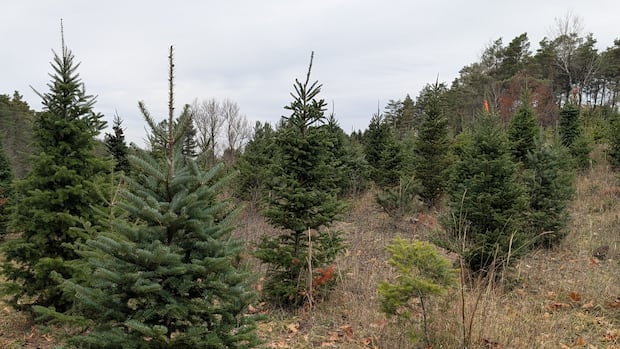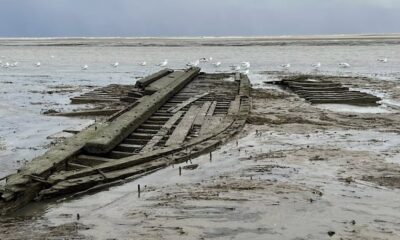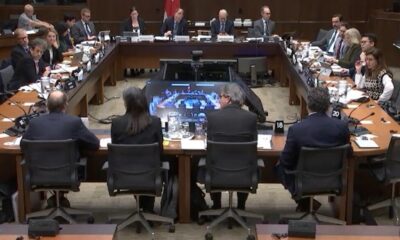Top Stories
Climate Crisis Forces Urgent Changes in Christmas Tree Farming

UPDATE: Christmas tree farmers are facing a critical crisis as climate change and rising living costs reshape the industry. Michael Cormack, a third-generation farmer in Goodwood, Ontario, warns that unpredictable weather has wreaked havoc on his farm, with temperatures soaring above 29°C this past July causing significant tree losses. “Mother nature is a big, big factor in the business,” Cormack stated in an urgent interview.
The effects of the climate crisis are hitting home just as the holiday season approaches. Cormack noted a stark decline in young couples and small families visiting his farm, with multi-generational groups now sharing single trees. This shift signals a deeper trend shaped by economic pressures as families cut back on holiday spending amid a cost of living crisis.
Experts from the University of Waterloo, including director Kelsey Leonard, highlight that the aging demographic of tree farmers poses another challenge. “Many farms are owned by elderly growers who are aging out,” Leonard explained. “We’re losing farms year after year, which is unfortunate.”
Moreover, rising land costs and U.S. tariffs on equipment are pushing operational costs higher. Leonard warns that the full impact of these tariffs on the Christmas tree industry won’t be clear until after this holiday season, adding to the uncertainty facing farmers.
As consumers grapple with the choice between real and artificial trees, environmental concerns remain paramount. New studies from the University of New Brunswick indicate that species like balsam firs are increasingly vulnerable to climate change. Leonard emphasizes that buying a real tree from local farmers is the most eco-friendly option, despite some consumers opting for artificial trees due to allergies or space restrictions.
The ongoing debate about the environmental impact of real versus artificial trees is intensifying. While many artificial trees are made from plastic, which is a product of fossil fuel consumption, experts note that keeping an artificial tree for at least 20 years is necessary to offset its carbon footprint. “Most people don’t keep those trees that long,” Leonard pointed out, describing them as a “fast fashion fad.”
As the holiday spirit begins earlier each year, Cormack notes a marked shift in consumer behavior since the pandemic, with peak purchasing moving from mid-December to November. “Our big weekend used to be around December 15, and now it’s pushing into November,” he said.
For those who do choose artificial trees, Leonard advises maximizing their lifespan through reuse and recycling. “Try to find ways to repurpose, reuse, and recycle it,” she urged, advocating for environmentally conscious disposal practices.
Despite these challenges, Cormack reassures that Christmas tree farming remains sustainable. “Every year that we cut one, we usually plant two or three,” he explained, likening the practice to traditional crop farming. This commitment to sustainability may sway public opinion back in favor of real trees, countering the brief trend towards artificial options.
As the holiday season looms, consumers are urged to consider the broader implications of their choices and support local farmers facing unprecedented challenges. With climate change pressing down on the industry, the future of Christmas tree farming hangs in the balance.
-

 Politics3 weeks ago
Politics3 weeks agoSecwepemc First Nation Seeks Aboriginal Title Over Kamloops Area
-

 World4 months ago
World4 months agoScientists Unearth Ancient Antarctic Ice to Unlock Climate Secrets
-

 Entertainment5 months ago
Entertainment5 months agoTrump and McCormick to Announce $70 Billion Energy Investments
-

 Lifestyle4 months ago
Lifestyle4 months agoTransLink Launches Food Truck Program to Boost Revenue in Vancouver
-

 Science5 months ago
Science5 months agoFour Astronauts Return to Earth After International Space Station Mission
-

 Technology3 months ago
Technology3 months agoApple Notes Enhances Functionality with Markdown Support in macOS 26
-

 Top Stories2 months ago
Top Stories2 months agoUrgent Update: Fatal Crash on Highway 99 Claims Life of Pitt Meadows Man
-

 Lifestyle2 months ago
Lifestyle2 months agoManitoba’s Burger Champion Shines Again Amid Dining Innovations
-

 Politics4 months ago
Politics4 months agoUkrainian Tennis Star Elina Svitolina Faces Death Threats Online
-

 Sports5 months ago
Sports5 months agoSearch Underway for Missing Hunter Amid Hokkaido Bear Emergency
-

 Politics4 months ago
Politics4 months agoCarney Engages First Nations Leaders at Development Law Summit
-

 Technology5 months ago
Technology5 months agoFrosthaven Launches Early Access on July 31, 2025




















